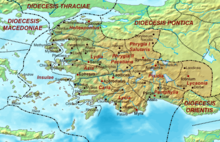
Tabala (Ancient Greek: Τάβαλα), was a Roman and Byzantine town and a Bishopric in ancient Lydia (now Turkey). Tabala was on the Hermus River, and minted its own coins.[1][2] It was probably mentioned by Hierocles under the name of Gabala,[3] which is perhaps only miswritten for Tabala. It is even possible that it may be the town of Tabae or Tabai (Τάβαι), which Stephanus of Byzantium assigns to Lydia.[4]
Its site is located near Burgaz in Asiatic Turkey.[5][6]
Bishopric[edit]
A See at Tabala was founded in the Roman era, and remains today a titular see of the Roman Catholic Church.[7][8] Known Bishops
- Polycarp (Council of Chalcedon)[9]
- Johannes Peter Franziskus Ross (18 May 1928 Appointed - 26 Dec 1969)[10][11]
References[edit]
- ^ John Anthony Cramer, A geographical and historical description of Asia Minor, Volume 1 (The University Press, 1832) p454.
- ^ W. M. Ramsay, The Historical Geography of Asia Minor p132.
- ^ Hierocles. Synecdemus. Vol. p. 670.
- ^ Stephanus of Byzantium. Ethnica. Vol. s.v. Τάβαι.
- ^ Richard Talbert, ed. (2000). Barrington Atlas of the Greek and Roman World. Princeton University Press. p. 56, and directory notes accompanying. ISBN 978-0-691-03169-9.
- ^ Lund University. Digital Atlas of the Roman Empire.
- ^ Joseph Bingham, Origines Ecclesiasticae; Or the Antiquities of the Christian Church and Other Works: In Nine Volumes, Volume 3 (Straker, 1843)
- ^ Antoine Augustin Bruzen de La Martinière, Le grand dictionnaire géographique et critique, Volume 6(P. Gosse, 1736) p150.
- ^ Richard Price, Michael Gaddis, The Acts of the Council of Chalcedon, Volume 1 (Liverpool University press, 2005) p361].
- ^ Annuaire Pontifical Catholique, Year 1932.
- ^ Revue des Ordinations Épiscopales, Issue 1928, Number 51.
![]() This article incorporates text from a publication now in the public domain: Smith, William, ed. (1854–1857). "Tabala". Dictionary of Greek and Roman Geography. London: John Murray.
This article incorporates text from a publication now in the public domain: Smith, William, ed. (1854–1857). "Tabala". Dictionary of Greek and Roman Geography. London: John Murray.
38°37′11″N 28°48′39″E / 38.61964°N 28.81076°E
Well, that’s interesting to know that Psilotum nudum are known as whisk ferns. Psilotum nudum is the commoner species of the two. While the P. flaccidum is a rare species and is found in the tropical islands. Both the species are usually epiphytic in habit and grow upon tree ferns. These species may also be terrestrial and grow in humus or in the crevices of the rocks.
View the detailed Guide of Psilotum nudum: Detailed Study Of Psilotum Nudum (Whisk Fern), Classification, Anatomy, Reproduction